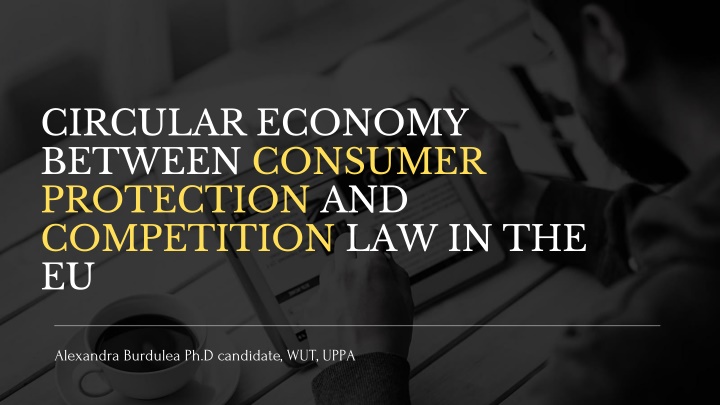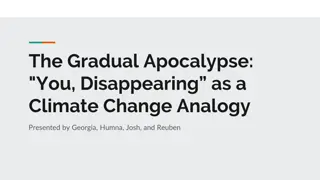
Circular Economy and Consumer Protection in EU Competition Law
This analysis delves into the intersection of consumer protection and competition law within the context of the circular economy in the European Union. It explores the evolving dynamics between consumer welfare, environmental considerations, and market interventions while emphasizing the need for a balanced approach to ensure the well-being of consumers and promote sustainability.
Download Presentation

Please find below an Image/Link to download the presentation.
The content on the website is provided AS IS for your information and personal use only. It may not be sold, licensed, or shared on other websites without obtaining consent from the author. If you encounter any issues during the download, it is possible that the publisher has removed the file from their server.
You are allowed to download the files provided on this website for personal or commercial use, subject to the condition that they are used lawfully. All files are the property of their respective owners.
The content on the website is provided AS IS for your information and personal use only. It may not be sold, licensed, or shared on other websites without obtaining consent from the author.
E N D
Presentation Transcript
CIRCULAR ECONOMY BETWEEN CONSUMER PROTECTION AND COMPETITION LAW IN THE EU Alexandra Burdulea Ph.D candidate, WUT, UPPA
Consumer welfare The notion of consumer welfare is not clearly defined under competition law. Is a clean environment part of the welfare equation? Competition law- consumer protection Therelationship between systems Individual consumer harm (consumer protection) is essentially a result of a failure of the market that impedes the consumer from maximizing his/her own wealth Common issues How much intervention is too much? Too much intervention may harm business flexibility and innovation to the detriment of the consumer; too little intervention may open up the prospect of a market that operates in an anti-competitive manner to the disadvantage of consumers (sustainability agreements that lead to price increases).
Linking policy objectives Environmental protection as an EU objective Article 3(3) TEU Article 7 TFEU Art. 11 TFEU Environmental protection requirements must be integrated into the definition and interpretation of the Union policies and activities, in particular with a view to promoting sustainable development The Union shall ensure consistency between its policies and activities taking all of its objectives into account . The Union . . . shall work for the sustainable development of Europe . . . and a high level of protection and improvement of the quality of the environment
Consumer welfare There are conflicting views regarding the consumer welfare test adopted under the EU competition law framework. While some authors, such as Simon Holmes argue that this standard needs to be reframed in order to accommodate the moral imperative of climate change, others such as Albertina Albors-Llorens and Alison Jones claim that the interests of consumers are insufficiently protected nowadays in the EU. Their analysis suggests that the meaning of consumer welfare should be located in contrast to other fundamental policy concepts of competition law, such as market efficiency or fair competition.
Consumer protection Competition law all those on the consumer (buyer) side, whether direct or indirect users. any natural person who is acting for purposes which are outside his trade, business, craft or profession Only natural persons Natural and legal persons
Consumer protection and the environment The goal of consumer protection is securing the exercise of individual rights. Environmental protection seeks to ensure collective welfare. = An inherent tension
Consumers as market regulators As argued by Christopher Hodges, consumer pressure on businesses can lead, under certain conditions, to them becoming direct regulators on the market. Enforcement mechanisms put at their disposal by consumer protection legislation Individual purchasing decisions for circular products
Consumers may be easily dissuaded to claim their individual rights before national courts in private litigation. Creating synergies Enforcement by a competition authority is more likely to persuade businesses towards circular practices (higher penalties and possibility of being obliged to issue a public statement.
misleading and aggressive commercial practices; mandatory software updates that modified functional characteristics and significantly reduced the performances; no prior notice regarding the effects of updates; limited information for fixing the problems created by the updates. intentional acceleration of replacement. The Apple and Samsung Cases
The Italian Competition Authority held that the two manufacturers breached Arts. 5, 6, 7 and 8 of Directive 2005/29/EC on Unfair Commercial Practices. It applied sanctions more typical for competition law rather than consumer protection (fine and obligation to publish the decision). The Apple and Samsung Cases Both modified their policies as a result.
Thank you Alexandra Burdulea West University of Timi oara, Universit de Pau et des Pays de l'Adour alexandra.burdulea@e-uvt.ro






















